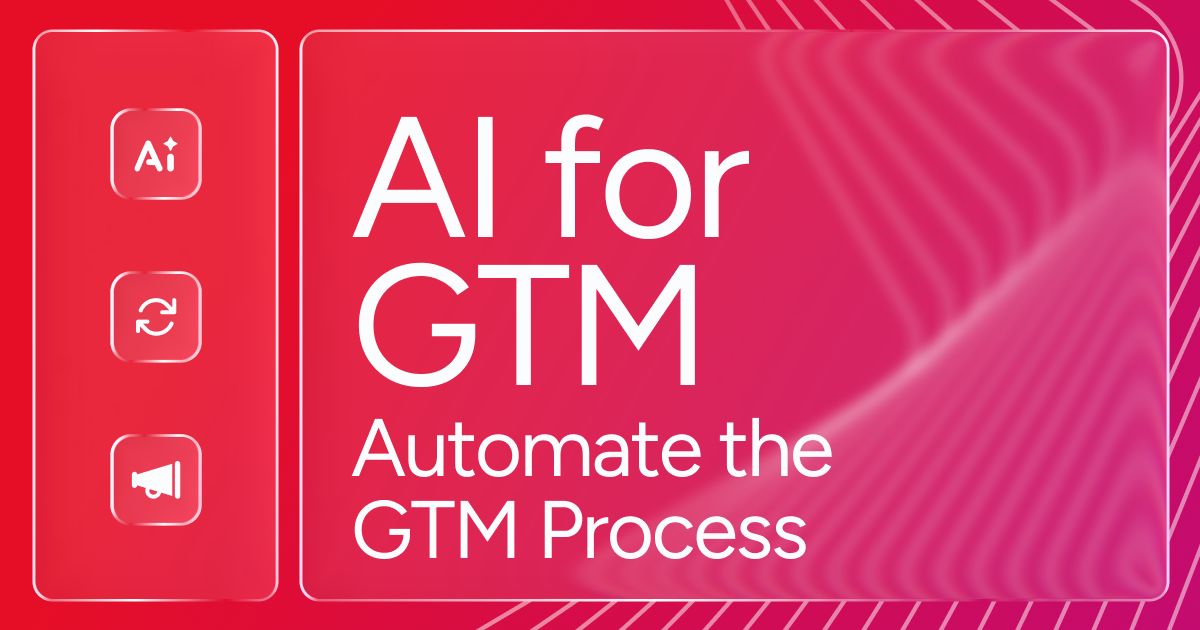Go-to-market (GTM) and revenue leaders aren’t just layering on tools. They’re rethinking execution from the ground up. The old playbook, with sales and marketing operating in parallel, is too slow and too siloed.
Today’s GTM motion runs on coordination, speed, and compounding intelligence. For leaders exploring how to automate the GTM process, that shift means adopting AI for GTM as the foundation, integrating go-to-market automation tools that drive speed, intelligence, and alignment.
That means AI and automation at the core. From routing to scoring to content, automation is now baseline. And AI is fast becoming the front door to every seller’s workflow.
By 2027, 95% of seller research will start with AI. That’s up from under 20% in 2024. Combine AI with automation and you’re not just faster, you’re smarter. You get coordination, speed, and a buyer journey that actually works.
What is GTM Automation?
GTM automation is the use of technology to automate sales, marketing, and revenue enablement tasks to streamline the process of bringing a product to market. It involves using software & AI to handle repetitive tasks like lead assignment, personalized email campaigns, and content creation. GTM automation allows teams to focus on strategic activities and relationship building instead of manual task execution. The goal is to increase efficiency, improve the customer experience, and accelerate revenue growth by making the entire go-to-market process smarter and faster.
How GTM Strategy Has Evolved
What used to be a relay race — product to marketing to sales to success — is now a frictionless loop. Modern GTM execution demands more than clean hand-offs. It requires constant alignment, fast feedback loops, and shared intelligence across every stage of the buyer journey.
AI and automation are at the center of that shift. They shrink the lag between insight and action. Market signals become behavior insights. Insights drive smarter segmentation. Segments trigger real-time outreach, and every step feeds the next.
This evolution reflects a larger trend toward AI-driven sales and marketing alignment, ensuring every team, from marketing to success, operates from the same intelligent playbook.
The Benefits of AI and Automation in GTM
AI and automation are the backbone of AI for GTM, reshaping how to automate the go-to-market process for scale and speed.
They’re performance levers, compressing time, reducing manual drag, and turning lag into lift. Here’s how top GTM teams are putting them to work.
Improving sales efficiency
Sales reps waste hours on tasks that don’t drive revenue: manual lead routing, follow-up scheduling, basic research. Automation handles the handoffs, freeing reps to focus on conversations, not clicks.
Early AI adoption in sales teams delivered a 30% or better improvement in win rates
83% of AI-using sales teams saw revenue growth, compared to 66% of those not using AI
Roughly one-third of all sales tasks are automatable with today’s tech
The best go-to-market automation tools now automate routing, enrichment, and scoring, core markers for AI-driven sales efficiency.
Actionable takeaway: Audit your sales workflows. Eliminate manual bottlenecks in lead routing, CRM updates, and initial qualification, then track conversion lift per rep.
Enhancing customer engagement with personalized outreach
The best messaging is timely, relevant, and buyer-specific. Automation gets it there fast. AI makes it smart. Together, they move beyond batch-and-blast into high-conversion, intent-driven plays.
52% of sales pros use AI for data analysis ( such as lead scoring and pipeline forecasting), a key enabler of smarter outreach
AI-backed segmentation and personalization play a direct role in increasing deal velocity and win rates
High-performing sales teams are 61% more likely to use automation than underperformers
This kind of AI-driven sales and marketing alignment helps every touchpoint deliver personalized value, not just automation for automation’s sake.
Practical application: Use AI to map buyer behavior to messaging cadences, then deploy automation to deliver those cadences on time. Run A/B tests on static versus dynamic content paths to measure uplift.
Strategic business benefits in scalability, alignment, revenue growth
This is where AI and automation move from tactical wins to strategic force multipliers. You’re not just speeding up tasks, you’re building a GTM system that scales, aligns, and predicts. That’s the essence of how to automate the GTM process, creating a continuous, AI-powered feedback loop across the customer lifecycle.
60% of companies already use automation in daily workflows, reflecting how common the shift has become
Top-performing organizations that invest in AI and automation optimize processes at more than twice the rate of their lower-performing peers.
Practical application: Don’t chase alignment, bake it in. Use automation to unify data handoffs, standardize playbooks, and set shared KPIs across sales, marketing, and success.
Real GTM Automation Outcomes from Real Teams
Abstract claims don’t move pipelines. Proof does. Here’s how real companies are getting GTM results with AI and automation.
Snowflake: Doubling conversion rates with smarter targeting
Snowflake used ZoomInfo’s technographic and firmographic data to refine its targeting and sharpen outreach across top-tier accounts. The impact was immediate:
25% increase in engagement across top customer segments
2X new customer conversion rate among strategic targets
With clean, rich data informing the GTM motion, Snowflake drove tighter segmentation, more precise outreach, and stronger pipeline impact. That’s not just better targeting, it’s real revenue lift.
Outreach: Accelerating pipeline with cleaner data
Outreach integrated ZoomInfo into its prospecting engine to fix data gaps and accelerate top-of-funnel execution. The results:
7X improvement in connect rates in just three weeks
67% reduction in connect time, meaning reps got to conversations faster
With better contact data, reps worked smarter, connected sooner, and advanced pipeline faster.
Lessons from the field: what smart teams get right
These wins didn’t happen by accident. The most effective AI/automation rollouts share a few key patterns:
Start narrow. Pick one high-impact problem such as lead scoring or rep task automation and solve it well.
Build cultural buy-in. Train teams. Set expectations. Reinforce the shift from manual grind to data-driven action.
Invest in data hygiene. You can’t automate chaos. Clean inputs drive smart execution.
Track revenue impact. Don’t just measure usage. Measure cycle time, conversion lift, pipeline velocity, and deal size.
These aren't tech plays, they’re operational upgrades. Treat them accordingly.
Future Trends: What’s Next for AI and GTM
This space is evolving fast. The gap between early adopters and laggards is already visible in pipeline velocity and revenue outcomes. Here’s where AI and GTM are headed, and what GTM teams need to watch next.
Emerging Trends
Agentic AI: These systems go beyond recommendation into action. Expect platforms that autonomously run sequences: prospecting, follow-ups, meeting scheduling, and even proposal generation, all with minimal human oversight.
Blurred GTM Roles: Sales, marketing, and customer success will increasingly operate as integrated pods. AI and automation will drive shared workflows, aligned metrics, and unified revenue motions. “Handoff” becomes obsolete.
Low-Code/No-Code GTM Automation: Non-technical GTM practitioners will build and launch their own workflows. Expect drag-and-drop builders to become core GTM infrastructure, allowing frontline teams to automate without engineering bottlenecks.
AI Ethics, Governance, and Data Privacy: As AI becomes foundational to GTM, companies will be held accountable for bias, explainability, and compliance. Expect formal governance models around AI use in lead scoring, outreach prioritization, and customer segmentation.
GTM Intelligence Layers: Beyond dashboards, GTM tools will shift toward real-time intelligence overlays, with AI surfacing what’s happening and what to do next. This includes smart forecasting, dynamic territory planning, and pipeline risk detection, all in-platform.
Verticalized AI Models: Industry-specific models trained on sector data will outperform generalist tools. Expect GTM AI tuned for verticals like healthcare, manufacturing, or SaaS to emerge with better recommendations and context.
How to get ahead
You don’t need to overhaul everything overnight. But you do need to start moving now, before these shifts harden into advantages for someone else.
Lock in your data infrastructure with buyer profiles, signal capture, and CRM hygiene
Run one high-impact automation use case in Q1 and build momentum
Train your teams on what AI can do and what it shouldn’t
Prioritize flexible platforms over monolithic tools to achieve modular wins
Track pipeline velocity, conversion rate, and deal quality
If you wait for these trends to become standard, you’ll be too late. The best GTM teams aren’t reacting. They’re architecting what comes next.
Move First or Fall Behind
The question isn’t "should we use AI in GTM?" It’s "what’s still manual that shouldn’t be?"
GTM leaders who move first already see the upside: more efficiency, cleaner data, faster plays. It’s a reset on how teams plan, act, and scale. AI and automation aren’t bolt-ons. They’re the new backbone.
So get strategic. Run a pilot. Tie it to revenue. Start small but start now. Learning how to automate the go-to-market process with AI for GTM is the competitive edge your pipeline needs. Build the GTM motion your competitors are still talking about.


